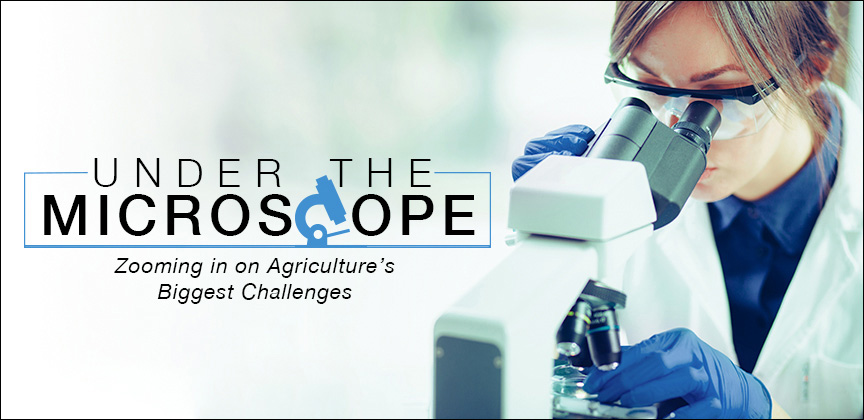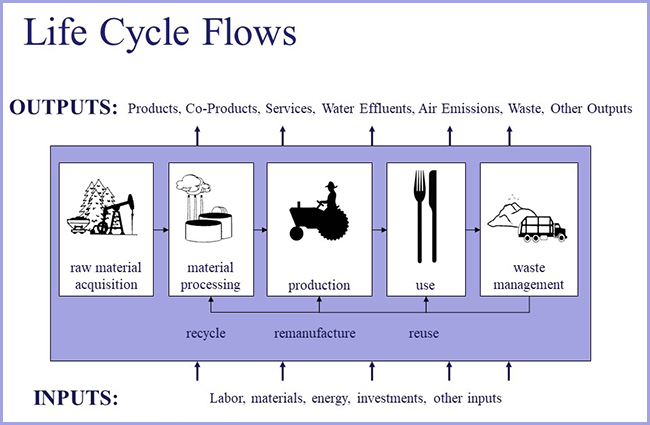
Addressing Climate Change Through Data
 |
Ezra Kahn and Peter Arbuckle are Technical Information Specialists with the National Agricultural Library (NAL). NAL has partnered with other federal agencies to form the Federal LCA Commons, a coordinated interagency approach to addressing climate change through the development and application of Life Cycle Assessment |
Welcome Ezra and Peter to Under the Microscope.
UM – The Federal LCA Commons is a major collaboration among many different agencies and disciplines. What are the short and long-term goals of this partnership?
EK: Life Cycle Assessment (LCA) is a powerful tool to assess the total environmental impact of a product. Our short-term goal is to build a community of experts, share our expertise, and find new opportunities to collaborate to advance our collective LCA capacity.
PA: Through our community we identified goals to coordinate a federal approach to address climate change. Our long-term goal is to continue to build foundational datasets and knowledge management infrastructure to support the use of LCA in industry and public policy. Our mission is to provide products and services that are “below the value line,” which industry can use to meet environmental performance goals.
UM – Members include EPA, DOE, DOT, and energy organizations. How did a USDA agency get involved, and how will this collaboration benefit our food suppliers?
PA: NAL is a natural home for a knowledge-based initiative such as the LCA Commons -- our mission is to facilitate the creation of food and agriculture-related knowledge and make agriculturally important information available to the public. The Library’s first LCA project was an open access LCA repository for agricultural products, including commodity crops, poultry, swine, and beef. As we evolved our data collection, management, and publication infrastructure, demand for these services increased from our federal partners. These agencies maintain data sets that are products of their research and services but providing public access to these products is outside of their mission. That’s where NAL’s LCA Commons comes in.
EK: LCA can be a powerful tool for farmers and food producers to improve their management practices and realize the benefits and savings of their practices and investments. For example, carbon emissions reduction and carbon storage are becoming national priorities, and they involve all sectors of the economy. The tools and data developed by the LCA Commons can facilitate a proactive approach to identifying opportunities to address carbon emissions reduction. Using the standardized methods developed by LCA Commons allows for the LCA work of the agricultural community to be reused in decision-making for other programs, such as bio-preferred purchasing, renewable fuels standards, and soil carbon storage incentive programs.
 The Federal LCA Commons is a major collaboration among many different agencies and disciplines.
The Federal LCA Commons is a major collaboration among many different agencies and disciplines.
UM – Your major products are data that support LCA, which can be used by industry members to meet government regulations and standards, correct? Please elaborate on what the LCA entails.
EK: Yes, LCA is used by some industries to meet government standards, in particular California Low Carbon Fuels Standards and Buy Clean California. However, LCA can be used for much more than regulatory compliance. LCA is fundamentally a tool which firms use to analyze the environmental impacts of their product supply chains to improve resource efficiency and reduce costs. It’s like when you decide you want to save money, the first thing you do is track income and expenses to understand exactly how money is coming in and going out so you can better control and manage your budget.
PA: LCAs are also being used by agricultural industry associations to benchmark industrywide greenhouse gas emissions and other aspects of environmental performance. In the case of beef production, the LCA provides overall carbon, nitrogen, water, and energy balances for beef production, and shows how energy and nutrient intensity has changed over time. Check this out: https://digitalcommons.unl.edu/hruskareports/263/
UM – Your first collaboration was creating a U.S. electricity baseline. How is this baseline already being used by industry and government?
PA: Electricity data is something everyone needs and is a data input to every economic activity modeled in an LCA. Electricity’s prevalence means the carbon and energy intensity of a product over the life cycle is often very sensitive to the amount of electricity used and the way it was produced. LCA Commons members collaborated to develop a high-quality electricity dataset based on reported electricity generation and trading statistics. This dataset is now used as the foundation for a wide range of applications, including pavement design, carbon capture storage and utilization, and construction and demolition equipment use. The adoption of a single baseline model for an input so widely used means the datasets and outcomes from these LCAs can be compared on an apples-to-apples basis, and reused in new LCA studies to generate new knowledge.
 Life Cycle Assessment is a powerful tool to assess the total environmental impact of a product.
Life Cycle Assessment is a powerful tool to assess the total environmental impact of a product.
UM – You mentioned that Federal LCA Commons provides services that are “below the value line.” Please explain:
PA: It’s like the seatbelts in a car. Car companies don’t compete or differentiate themselves with their seatbelts. They collaborate with each other and the government to make sure that seatbelts meet specified consensus standards. The U.S. Electricity Baseline is a nice example of this. Electricity consumption is a component of nearly every industrial activity, and therefore, nearly every LCA uses an electricity data set. However, it is not cost effective for each firm to develop their own electricity model. Also, subsequent results across firms and sectors would not be comparable. It makes sense that the key foundational data sets which firms don’t use to differentiate themselves be collected as a public good by the government.
UM – How can farmers and ranchers use LCA data to improve their bottom line, while at the same time be good stewards to the environment?
PA: LCA is another type of accounting tool that allows farmers and ranchers to view their operations through an alternative lens to provide new insights into management practices. Something really powerful is that often times addressing negative impacts can also lower production costs. For example, a farmer used the knowledge from an LCA to implement a wide range of environmentally beneficial practices to improve resource efficiency that also reduced production costs $30-$50 per acre. LCA can help identify these win-win opportunities.
EK: LCA could also be used to communicate the environmental benefits changes in practices far away from the field. For example, LCA results might lead a farmer to implement precision agriculture techniques, which reduce the number of passes on a field or the amount of water pumped. The reduction in tillage and energy usage can reduce the life cycle carbon impact of an operation by including the emissions at the power plant and refinery in addition to losses from the field. This life cycle perspective can give a full accounting of the benefits of new investment beyond the boundaries of a producer's land or facility.

UM – One of the challenges of nationwide data collection, especially with regards to agriculture, is the stark differences between the many regions and climates across our lands. How can a farmer or infrastructure builder in Iowa, for example, analyze this data to meet their needs?
EK: Regional specificity is one of the great outstanding challenges to accurate LCA. For example, the impacts of using electricity in the Pacific Northwest, where there is a lot of hydro generation, is much different than in the Mid-Atlantic, which has a lot of fossil generation facilities. Having that specificity is critical to accurate LCA. Compared to power generation, agricultural systems are much more geographically diverse, have more complex environmental interactions, and are often highly integrated with many valuable products depending on each other.
PA: There is a real need for greater development in how agricultural systems are modeled in LCA, especially getting production practices and regional differences accurately understood. There has been a lot of interest in creating Environmental Product Declarations (EPDs) for consumer goods, including food. An EPD is basically a nutrition label created from an LCA – but instead of communicating nutrition, it is for total environmental impacts like climate change potential, acidification, and energy use for the entire supply chain. For these types of labels to be meaningful, there needs to be accurate measurements and representation of specific production practices at precise locations and points in time. I think the LCA community still has a lot to learn about modeling agricultural systems for this kind of use.
UM – Besides electricity, what areas are the Federal LCA Commons collecting data on?
PA: Our current projects include working with the U.S. Forest Service, Forest Products Lab on wood-based construction materials and other forest derived energy products. Our academic partners provide LCA data for poultry, beef, and swine production, and a range of field crops including: oats, cotton, corn, soybeans, peanuts, and rice. We also have data developed on bio-based products such as pulp and paper. Our federal partners publish data on coal extraction and production, vehicle and transportation systems, construction equipment operation, and waste management. We also host the “US LCI” as a service to the National Renewable Energy Laboratory. The US LCI maintains datasets from industries as diverse as plastics to printers.
UM – Agriculture is one of the biggest emitters of greenhouse gasses. How do you see these data sets assisting with carbon sequestration?
EK: Reducing greenhouse gas emissions and sequestering atmospheric carbon dioxide are strategies for addressing climate change. For agriculture, addressing climate change must be considered alongside the critical social and economic drivers our farmers face. LCA’s total supply chain perspective gives producers and decision makers another powerful tool to identify and implement greenhouse gas emissions and carbon sequestration strategies while protecting our food supply and developing our rural communities. Our goal is to develop the methods and data to underpin more holistic carbon management strategies.
